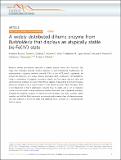A widely distributed diheme enzyme from Burkholderia that displays an atypically stable bis-Fe(IV) state
Author(s)
Drennan, Catherine L; Cohen, Steven E.,Ph. D.Massachusetts Institute of Technology.
DownloadPublished version (1.459Mb)
Terms of use
Metadata
Show full item recordAbstract
Bacterial diheme peroxidases represent a diverse enzyme family with functions that range from hydrogen peroxide (H₂O₂) reduction to post-translational modifications. By implementing a sequence similarity network (SSN) of the bCCP_MauG superfamily, we present the discovery of a unique diheme peroxidase BthA conserved in all Burkholderia. Using a combination of magnetic resonance, near-IR and Mössbauer spectroscopies and electrochemical methods, we report that BthA is capable of generating a bis-Fe(IV) species previously thought to be a unique feature of the diheme enzyme MauG. However, BthA is not MauG-like in that it catalytically converts H₂O₂ to water, and a 1.54-Å resolution crystal structure reveals striking differences between BthA and other superfamily members, including the essential residues for both bis-Fe(IV) formation and H₂O₂ turnover. Taken together, we find that BthA represents a previously undiscovered class of diheme enzymes, one that stabilizes a bis-Fe(IV) state and catalyzes H₂O₂ turnover in a mechanistically distinct manner.
Date issued
2019-03Department
Massachusetts Institute of Technology. Department of Chemistry; Massachusetts Institute of Technology. Department of BiologyJournal
Nature Communications
Publisher
Springer Science and Business Media LLC
Citation
Rizzolo, Kimberly et al. “A widely distributed diheme enzyme from Burkholderia that displays an atypically stable bis-Fe(IV) state.” Nature Communications, vol. 10, 2019, article 1101 © 2019 The Author(s)
Version: Final published version
ISSN
2041-1723